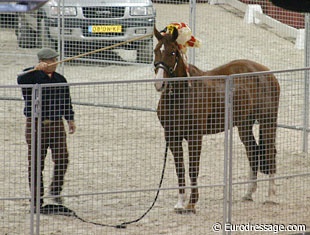
Researchers V. Fowler, M. Kennedy, and D. Marlin, of the Institute for Animal Health, Anglia Ruskin University, and Hartpury College made a scientific comparison between the Monty Roberts technique and a conventional UK technique for initial training of riding horses.
Their study describes the efficacy of the Monty Roberts horsemanship technique (MRT) in comparison to a UK conventional training technique (CT) for initial training of horses.
Horses consisted of 14 untrained horses, 4 mares and 10 geldings between the ages of 3 and 5 years old. Horses were matched on temperament by assessing i) difficulty when being lead in hand, ii) behavioural reactivity to a novel object test prior to being randomly assigned to either MRT or CT.
Trainers were selected in order to represent two differing styles of training horses. Monty Roberts (MRT) represented his own techniques whilst Phil Roelich, a conventional BHS registered horse trainer of 12 years, represented the conventional technique (CT). Each trainer was allowed 30 minutes per day to work with each horse for 20 days following which the horses undertook a standardised ridden obstacle and flatwork test and a ridden freestyle test. H
eart rate during the daily training sessions and the final assessments was recorded using a Polar RS800CX system. Horses were scored for technical performance by a panel of judges who were blinded to the nature of the study and the trainers involved. During first saddle and rider MRT trained horse had significantly lower (P=0.0137) maximum heart rates (bpm) (First saddle: 127±37, first rider: 76±12) when compared to CT (First saddle: 176±24, first rider: 147±61).
MRT trained horses had similar mean heart rates to CT trained horses (91±15 bpm, 80±7 bpm, respectively) during the ridden obstacle test but received significantly higher performance scores from the judges (171±4, 133±7, respectively; P<0.0001). MRT horses had similar mean heart rates to CT horses (81±13, 93±5 respectively) during the ridden flatwork test but were awarded significantly higher scores by the judges (149±9, 121±11, respectively; P=0.0005).
Thus the efficacy of the MRT for initial training of riding horses is greater than CT as determined by significantly lower maximum heart rates during first saddle and first rider and significantly higher performance scores during standardised ridden tests following 20 days of training.
The use of Monty Roberts horsemanship methods before and during putting a saddle and a rider on a horses back for the first time, results in lower heart rates in horses when compared to using UK conventional horsemanship methods. In addition horses trained for 20 days using Monty Roberts horsemanship method perform significantly better in ridden tests than horses trained using UK conventional horsemanship methods.
-- 2011 ISES conference abstract
Related Links
Confrontation with the Self: Monty Roberts
Monty Roberts Opens the 2007 Global Dressage Forum: "Think round"